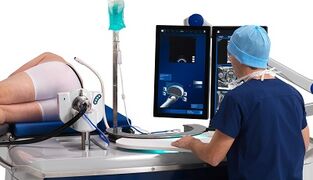Congestive prostatitis is a disease that occurs against the background of prostate gland dysfunction. The main cause of the development of this disease is stagnation in the prostate. Similar pathologies can develop in men of all ages. Recently, cases of detection of this disease in young people have become more frequent.
Reason

The occurrence of stagnation in the prostate always indicates the development of inflammatory processes that completely inhibit the function of the male prostate gland. The process of blood outflow is inhibited, and the glands stop completely emptying, resulting in stagnation of secretions.
Often the disease develops against the background of chronic prostatitis. Therefore, the patient may not be aware of the presence of stagnant processes in his body for a long time.
Prostate congestion can occur for a variety of reasons. As a rule, the disease is not bacterial in nature and manifests itself due to the influence of the following factors:
- Lack of constant intimate life. Frequent pleasure without subsequent ejaculation, inconsistent sexual intercourse, incomplete ejaculation, frequent sexual intercourse after prolonged abstinence can lead to the emergence of unstable processes.
- Anatomical features. If a person has insufficient venous valves or weakness of the urogenital plexus venous wall.
- Spinal injuries, as well as diseases such as herniated discs or osteochondrosis. With physical damage to the spine, there is a possibility of prolonged spasm of the prostate gland.
- Frequent body hypothermia, working in a room with active air conditioning, the presence of drafts, and so on.
- Bad habits - smoking, alcohol abuse. As a result, patients may experience paralysis of small ducts of the genitourinary system.
- Chronic increase in temperature in the pelvic organs. This phenomenon can also be attributed to anatomical features.
- Frequent colitis and diarrhea.
- Eating problems, dehydration.
According to most experts, the leading cause of stagnation lies in the varicose veins of the lower leg. In this case, there is a violation of the blood circulation of the pelvic organs, because the prostate begins to be filled with blood.
Often the cause of this disease can be an inflammatory process localized in the pelvic or rectal organs. Also, the disease can be caused by hormonal disorders.
Various acute or chronic infections can also provoke the process of stagnation in the prostate. Penetration of infection into the prostate gland occurs through the urethra. Also, the infection may occur through the rectum, through the blood or lymphatic vessels.
Who is at risk

Continuous sedentary work is a direct path to stagnant prostatitis.
Although the disease develops suddenly, the disease can be prevented if the provoking factors are removed from daily life. The risk of stagnation in the prostate is:
- People with an inactive lifestyle. First of all, we are talking about people who work while sitting.
- Patients who often suffer from constipation.
- Individuals who eat irregularly and neglect nutritious and healthy foods.
- Smokers and people with severe alcohol dependence.
Symptoms
In most cases, the disease is not symptomatic, and therefore it is almost impossible to determine its presence at home. The first sign of the disease is the presence of pain in the perineum area. Often gets worse with walking. Even so, the disease has certain symptoms, which should be discussed in more detail.
The main symptoms of congestive prostatitis are:
- Decreased potential and sexual drive. Erectile dysfunction.
- Decreased sperm quantity, decreased consistency.
- Frequent premature ejaculation.
- Decreases the quality of orgasm.
- Persistent burning sensation in the urethra and bladder.
- Problems with urination, which are intermittent and painful.
- There is pain in the groin that extends to the sacrum or inner thigh.
- There is constant burning and discomfort in the bladder and urethra.
Symptoms of nonspecific congestive prostatitis include general weakness, decreased performance, sleep disturbances, and general irritation.
Classification
Currently, congestion in the prostate can be seen with the following types of prostatitis:
- Chronic.As a rule, it develops in the absence of normal sex life or its replacement by masturbation. Obesity, sexual dysfunction, stress, lack of blood supply, inactive lifestyle - all of these factors eventually lead to the development of chronic prostatitis. In chronic prostatitis, ejaculation is usually secreted in the form of clots. Prostate massage or intercourse can improve a patient's condition, but the effects are short-lived.
- Venous.Appears in the presence of venous system pathology. If the patient is diagnosed with varicose veins, as a result of which there is an accumulation of venous blood in the small pelvic venous system, then the stagnant process can be localized in the prostate gland. The result is prostatitis.
- Congestive.It occurs as a result of incomplete emptying of the prostate gland, as a result of which it is always in a state full of blood, which contributes to the development of inflammation. Often, this form of prostatitis occurs in middle-aged men.
- Infectious.In this case, the cause of the disease is an infection that enters the prostate gland through the genitourinary system. If this occurs against the background of cognitive prostatitis, then the inflammatory process increases, and the general condition of the patient worsens.
Diagnostics

Prostatography of the prostate will help determine the exact picture of the disease.
Diagnostic measures must include prostate palpation, as well as examination of the posterior urethra. This is the basis for diagnosing prostatitis, which allows the specialist to determine whether the sensitivity is low or high. Also, the presence of this disease is evidenced by the release of a small amount of aseptic secretion.
Further, if the doctor suspects the development of the disease, the patient is sent to perform prostate rheography. This procedure is well tolerated by the patient, taking about fifteen minutes. According to the results of rheography, it is possible to identify violations of venous outflow, to obtain basic information about the condition of the vessel - its elasticity and integrity.
If blood flow to glandular tissue is difficult, then this indicates a degenerative change.
To confirm the diagnosis and obtain additional information, the following procedure is performed:
- Ultrasound of the pelvic organs.
- Prostatography of the prostate.
You can not do without laboratory diagnostic methods, which involve passing the following tests:
- Urine test.Includes general urine analysis, triple study and microflora culture. In the process of this analysis, pathogenic microflora, including chlamydia, are often undetectable.
- Blood test.We are talking about thromboelastography and coagulogram.
- Analysis of ejaculatory and prostate secretions.Often, with congestive prostatitis, leukocytosis is not detected. However, the sample contained columnar and squamous epithelial images.
The difference between congestive and infectious prostatitis

The disease is accompanied by frequent depression in men.
At the diagnostic stage, it is very important to distinguish unstable processes from infectious processes. Otherwise, the treatment will be chosen incorrectly, which can lead to some complications. Therefore, the specialist should pay attention to the following symptoms:
- Urinary problems - usually, patients urinate frequently in the morning. Further, his condition improved.
- Pain and soreness in the perineum, testicles.
- Fever with severe general fatigue.
- Depression and general anxiety.
- Erection problems and weak orgasm. Typically, ejaculatory quality deteriorates in patients, which can be detected during additional studies.
Initially, doctors performed palpation studies, in which they showed specific changes in the prostate. We can discuss the following features:
- enlarged organ;
- prostate gland contours are unclear;
- consistency changes;
- increased sensitivity;
- fineness of median sulcus contour observed.
Important!If any of the above symptoms occur, the patient does not show any signs of infection during laboratory tests.
The prostate secretion is characterized by a thick, prominent consistency in the form of lumps and clots. Similar changes were observed as a result of prostate massage. In some cases, the patient himself may notice lumps in the semen during ejaculation. This indicates the development of a stuck process.
Treatment
Treatment for illness includes quitting smoking altogether.
Treatment of congestive prostatitis is determined based on the degree of manifestation. Based on the results of a comprehensive diagnosis, the specialist determines the course of further treatment. As a rule, it uses an integrated approach and consists of the following procedures:

- Drug therapy.When treating a process that is blocked in the prostate, the patient should take anti-inflammatory medication. Doctors can also give other medicines to their patients.
- Pain relieversmay be prescribed for pain. They are usually taken with a blood thinner.
- Power mode.When stagnant prostatitis is detected, patients undergo a strict diet that involves a limited intake of spicy and fatty foods. The key to a speedy recovery is a balanced diet, when the patient's daily diet contains large amounts of fruits, vegetables, dairy products and fermented oils.
- Sex mode.It is important that the patient not only observes sexual hygiene, but also improves his or her intimate life. Regular sexual intercourse will normalize the function of the prostate gland and exclude the development of stagnant processes in the future.
- Stop bad habits.Many experts do not know how congestive prostatitis can be overcome by smoking or alcohol abuse. It is very important that the patient quits smoking and drinking alcohol completely, which can cause congestion. It is equally important to minimize negative factors such as hypothermia, physical load, physical inactivity, and so on.
- Physical activity.A large number of specialists prescribe special physiotherapy exercises for their patients. Exercises like these are usually aimed at strengthening the abdominal muscles, improving breathing, and tightening the pelvic floor muscles.
- Vitamin therapy.This is a very important step in the treatment of congestive prostatitis. The patient's body must get a variety of nutrients. For this purpose, vitamin complexes are most often prescribed for patients with congestive prostatitis.
If the cause of the development of congestive prostatitis in a man is a lack of venous valves in the lower part of the leg, then he will undergo surgical intervention.
Prevention
In this case, the basic precautionary measure is activity. Moreover, it should be expressed in movement and sex. Experts say that to prevent stagnation, the prostate gland must function regularly. Only ejaculation can provide this.
Moderate exercise, regular walking and regular diet will help prevent the development of the disease.
























